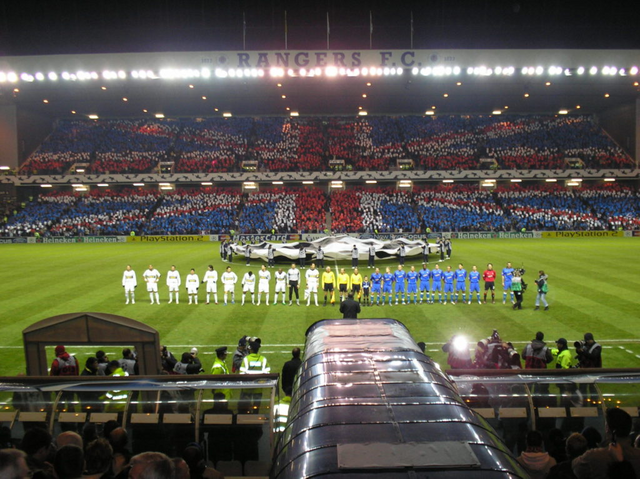
Two of the most prestigious football clubs in Europe call Glasgow home, Rangers FC and Celtic.
When these two teams play together in the Old Firm Derby they battle out in what has to be the most bitter of footballing and even sporting rivalries the world has seen.
So strong is their hatred for each other the derby is deeply embedded into Scottish culture. The derby has also contributed to political, social, religious and sectarian divides in Scotland.
We take a look at the royal blue side of Glasgow and explore what the meaning of a Rangers jersey is. If you’re born in Glasgow, your either one side or the other.
Founded in 1872 Rangers Football Club have won a world record 54 domestic league titles and 116 total cups.
They themselves have won a total of more than 43% of the top level of Scottish league football in history.
The very foundations of the club are built on Protestant roots in contrast to Celtic who are built on its Catholic Church support.
The Rangers Protestant supporters are therefore made up primarily of native Scots and Ulster-Scots compared to Celtic’s supporters coming from impoverished Catholic Irish immigrants traditionally from the city’s east end.
As a result of the make ups amongst both sets of supporters, Scottish flags are uncommon with Rangers fans more like to be waving the Union Jack and Celtic fans more likely the Irish tricolours based on their cultural and political links.
Such is the animosity between the two clubs, Rangers had an almost seven-decade long, unspoken and unwritten transfer policy of not knowingly signing Roman Catholic players.
This was only broken in 1989 when Graeme Souness recruited Mo Johnston, an ex-Celtic striker.
The colour royal blue is synonymous with the identity of Rangers.
Interestingly the majority of the first 50 years of the Rangers existence saw them playing in a plain lighter blue home shirt.
The exception to this was a switch to blue and white hoops in 1879 im an effort to change their fortunes at the time.
Eventually by decree of a committee in 1883 the blue was brought back.
Rangers moved from the lighter shade of blue to royal blue in 1921 and have had a royal blue home shirt every year since.
The design of the away strip has changed far more drastically. White and red have been the most common colours although Rangers have also opted for dark and light blue variations.
In 1994 a third kit which included combinations of white, red, black, orange, dark and light blue was introduced.
Despite being the most successful football club domestically in history the Rangers found themselves in a huge hole financially.
Poor decisions and dodgy deals led to the demise of the club under its previous corporate identity.
In 2011 the club was bought for £1 by Craig Whyte, largely outstanding tax bill debts. The club was rumoured to have amassed £49 million worth of debt.
By 2012 the club had gone into administration and administrators finally determined that the club owed at least £55 million to various creditors, as well as £79 million in unpaid taxes.
By June 2012 the liquidation process had started and the clubs assets were sold to Charles Green’s Sevco Scotland Ltd company for £5.5million.
The club quickly reorganised under the new company The Rangers Football Club Ltd. They reapplied to join the Scottish Premier League but we’re rejected.
Two weeks later they were approved to enter the fourth-tier SFL Third Division for the 2012/13 season.
They went from crowds of 50 000+ at the Ibrox the year before to playing infront of small Scottish towns, Annan Atheltic’s 2500 capacity Galabank stadium an example.
In more recent years Rangers and Celtic have distanced themselves from their sectarian history and have clamped down on fan violence.
People have lost loved ones over the years with the rivalry. An estimated eight deaths and thousands of assaults and arrests between 1996-2003 have been linked directly to the Old Firm rivalry.
A 2003 study showed that Rangers fans were made up of 65% Protestant and only 2% Catholic. A stark contrast to Celtic’s 74% Catholic and 10% Protestant make-up.
The Old Firm derby was estimated in 2005 to be worth £120 million to the Scottish economy each year, a reminder of the appeal the rivalry brings.
When you buy a Rangers FC jersey it represents far more than just the football team.
It represents the foundations of its Protestant foundations and a reminder of a world record of domestic league titles.
It also represents a divide in Glasgow, in Scotland as a whole with everlasting sectarian views on politics, religion and differing social attitudes.
Despite the perils of entering in administration and liquidation they have now returned to become one of the top clubs in Scotland again.
it means very much
Downvoting a post can decrease pending rewards and make it less visible. Common reasons:
Submit
Some things go deeper than sport and if you went to northern ireland you would see other places like this which have a lot of history.
Downvoting a post can decrease pending rewards and make it less visible. Common reasons:
Submit
Thanks for the reply. What rivalries do you have in NIR? I’d love to look into it.
Downvoting a post can decrease pending rewards and make it less visible. Common reasons:
Submit
Congratulations @ieriko! You have completed the following achievement on the Steem blockchain and have been rewarded with new badge(s) :
You can view your badges on your Steem Board and compare to others on the Steem Ranking
If you no longer want to receive notifications, reply to this comment with the word
STOPVote for @Steemitboard as a witness to get one more award and increased upvotes!
Downvoting a post can decrease pending rewards and make it less visible. Common reasons:
Submit